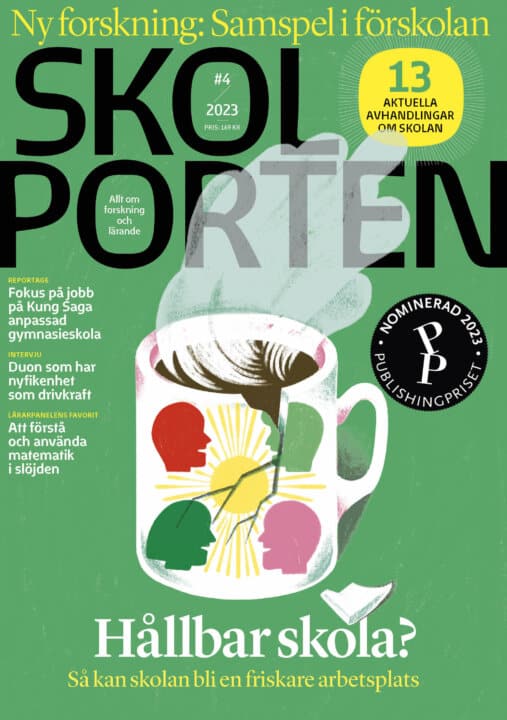Autism in Children; The importance of early detection and intervention
Nils Haglund har i sin avhandling bland annat utvärderat tidiga intensiva insatser för förskolebarn med autism.
Nils Haglund
Professor Karin Källén, Lunds universitet Professor Maria Råstam, Lunds universitet Peik Gustafsson, Lunds universitet
Professor Sven Bölte, CAP; Karolinska Institute/KIND
Lunds universitet
2017-09-08
Autism in Children; The importance of early detection and intervention
Autism in Children; The importance of early detection and intervention
The overall aim of this thesis was divided in three coherent parts. First, to detect potential risk factors for Autism Spectrum Disorder (ASD), secondly to develop and evaluate a new screening instrument for early detection of ASD in 30 months old children, and thirdly to evaluate a comprehensive intervention program for preschool children with ASD.
We wanted to investigate if evidence could be found for advantages of establishing a “care chain”, with early detection of ASD leading to the possibility participation in an early intervention program for the child and the family.
The first study was designed to investigate and compare pre- and perinatal risk factors for Autistic Disorder (AD) and Asperger Syndrome (AS) in a population from the south of Sweden. Case participants were children who were diagnosed with AD or AS at the Malmoe Child- and Adolescent Psychiatric Clinic, born 1980-2005, and attended to the Child- and Youth Habilitation Center in Malmoe during the period 1997-2007. The results from this study revealed two major findings, indicating that there was a difference between the two diagnoses according to potential risk factors. To evaluate the overall impact of obstetrical risk factors in the etiology of autism or Asperger syndrome, we combined the variables; birth before 37 weeks of pregnancy, Apgar score at 5 minutes below 7, small-for-gestational-age, and large-for-gestational-age, into a designed dichotomous variable. The OR (with 95% CI) for the combined variable ‘any obstetrical risk factor’, for AD was 1.7, and the corresponding OR for Asperger syndrome was 0.7, and the difference between the estimates for AD and Asperger syndrome was statistically significant (p = 0.02). We found significant difference in immigrant status when comparing the two groups of children. The study showed strong positive association between autism and maternal birth outside Sweden (OR 2.7). The highest OR for autism was found for children of women who were born in sub-Saharan Africa (OR 5.6), and this estimate differed significantly from the estimates for the other groups of women born outside of Nordic countries (p = 0.007). In contrast to this, a significant negative relationship between Asperger syndrome and maternal birth outside Sweden was found (OR 0.5).
In the second study, we developed and evaluated a new 12-item observational screening instrument for ASD in children aged 30 months, the Observation Scale for Autism (OSA). First, the instrument was validated by assessing 37 children diagnosed with Autism Spectrum Disorder (ASD), 23 with Down Syndrome (DS) and 26 typically developing children (TD). Of the children with ASD, 92% had more than four scores on the OSA compared to 17% in the group of children with DS and 0% in the group of TD children. The specificity improved when the original set of 12 items was reduced to a set including the 9 most discriminating items for ASD. The study indicated that the OSA managed to discriminate children with ASD from children with DS and TD children. Based on the results, a cut-off limit for suspect ASD was chosen (≥3).
In the third study, the OSA was evaluated in the setting of primary health care for children. In total, 2571 children were screened with the OSA, and a majority of the children (89%) were also screened with the Modified Checklist for Autism in Toddlers (M-CHAT). When screened at 30 months with the OSA, 35 children (1.4%) reached the cut-off for suspected ASD. Information on ASD diagnosis was retrieved from the Child and Adolescent Psychiatric clinic (CAP), and the children were all followed till at least 6 years (mean 7.3 years). We found that among all screened children, 26 were diagnosed with ASD (1.01%). Although promising results from the pilot study, both the OSA and the M-CHAT showed low Positive Predictive Value (PPV) as “stand-alone-instruments” in this naturalistic setting (PPV=14% and 7%, respectively). The M-CHAT showed higher sensitivity than the OSA (41% vs 19%), but also had a higher false- positive rate (93% compared to 86%). If the two instruments were combined (screened positive OSA and screened positive M-CHAT) acceptable PPV but low sensitivity was revealed. In this study we found none of the instruments, neither alone nor in combination, to have satisfying ability to identify children at risk for ASD.
In the fourth study, we evaluated an existing ABA-based intervention program for preschool children with ASD, the Comprehensive Intensive Early Intervention (CIEI) program. Improvement of Autism Diagnostic Observation Scale (ADOS) scores was compared between children participating in the CIEI program (n=67) and children receiving traditional habilitation services only (n=27). The pre- and post- intervention assessment (children participating in the CIEI program for approximately 2 years) showed a significant improvement of ADOS total scores in the CIEI group, whereas no such improvement was shown in the comparison group. The change difference (change among children in the CIEI group vs change in the comparison group) was also statistically significant, even after adjusted for possible confounders (-1.1; 95%CI -1.9 to -0.4). Children in the CIEI group also significantly improved their ADOS severity score, but not significantly different from the comparison group. Although the results from the study should be interpreted with caution, we conclude that they do support earlier studies reporting on improvement of autism symptoms after early intensive interventions.
To conclude, the thesis emphasize on the importance of early detection of children with ASD. In this subject, the thesis also emphasize on the difficulties correctly identify children at risk for ASD. The etiology in ASD is still at large unknown and different groups of children are at larger risk of being affected with ASD than others. Furthermore the thesis finds, as some previous investigators, no evidence to recommend universal screening for ASD with a special screening instrument. The early detection of affected children, should rather be implemented in disseminate knowledge in Child Health Care, in early signs of ASD and how they appear in toddlers and young children. In order to give affected children and their family proper support and interventions, there is a need to incorporate the Child Health Clinics in the already existing program including diagnostic assessment of ASD and treatment.Most important, the results from the thesis indicate that children with autism benefit from participating in early intensive intervention programs, and that investment in these programs may be highly justifiable.
Relaterade länkar

Biologi
 Åk 7–Vux
Åk 7–Vux Hållbar utveckling i förskolan
 Fsk
Fsk 




